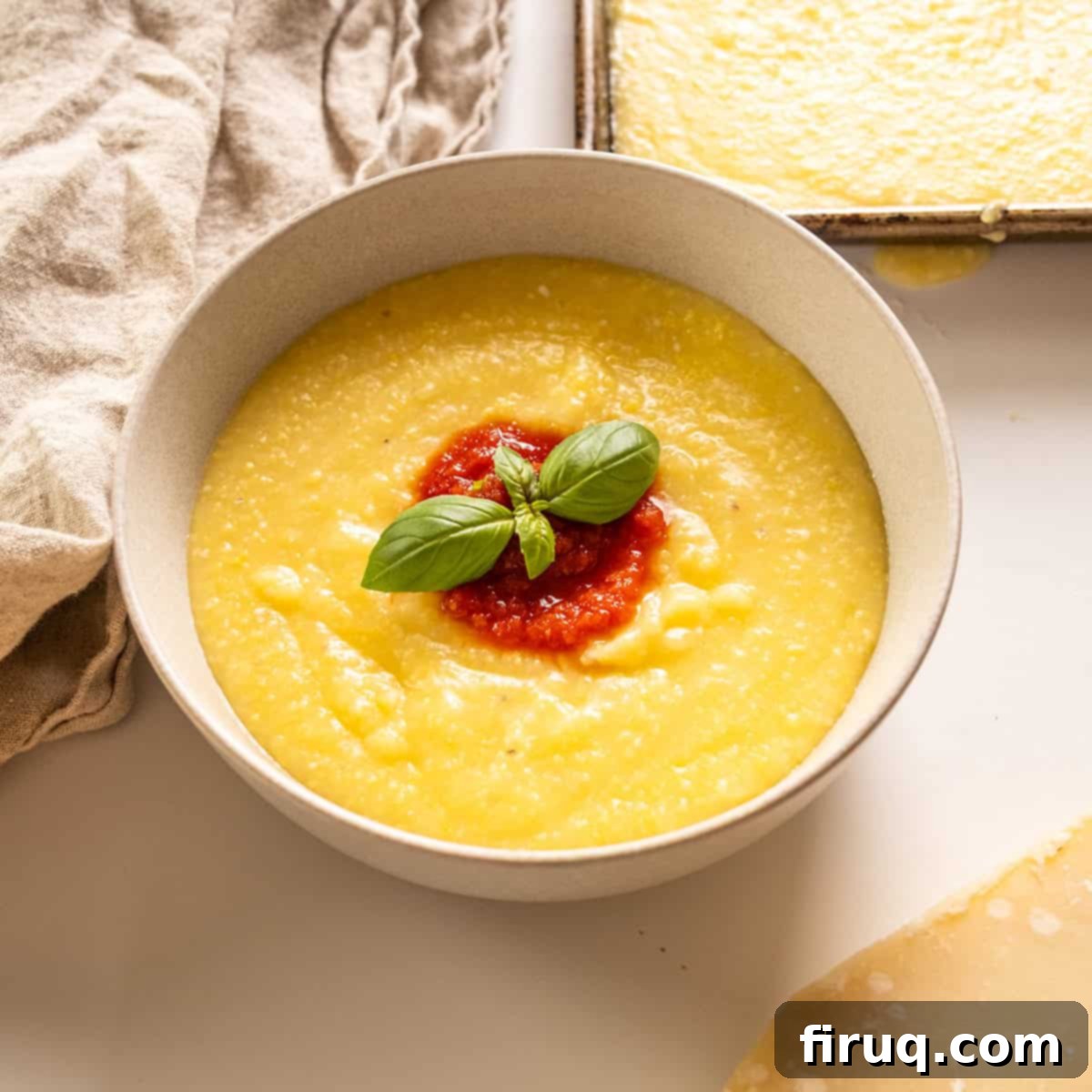Ultimate Creamy Polenta Recipe: A Timeless Italian Comfort Food
Imagine a dish that’s both incredibly simple and profoundly satisfying, a true cornerstone of Italian cuisine. That’s precisely what a Classic Creamy Polenta offers. When crafted perfectly, it boasts an unbelievably smooth, velvety texture, brimming with a rich and buttery flavor that warms you from the inside out. This humble yet elegant dish, often enriched with freshly grated Parmigiano Reggiano, evokes a sense of nostalgia with every cheesy, comforting bite. Traditionally, it’s served with a generous dollop of vibrant marinara sauce, creating a harmonious balance of creamy and tangy that’s simply irresistible. Polenta is more than just food; it’s an experience, a journey into the heart of Italian culinary tradition.
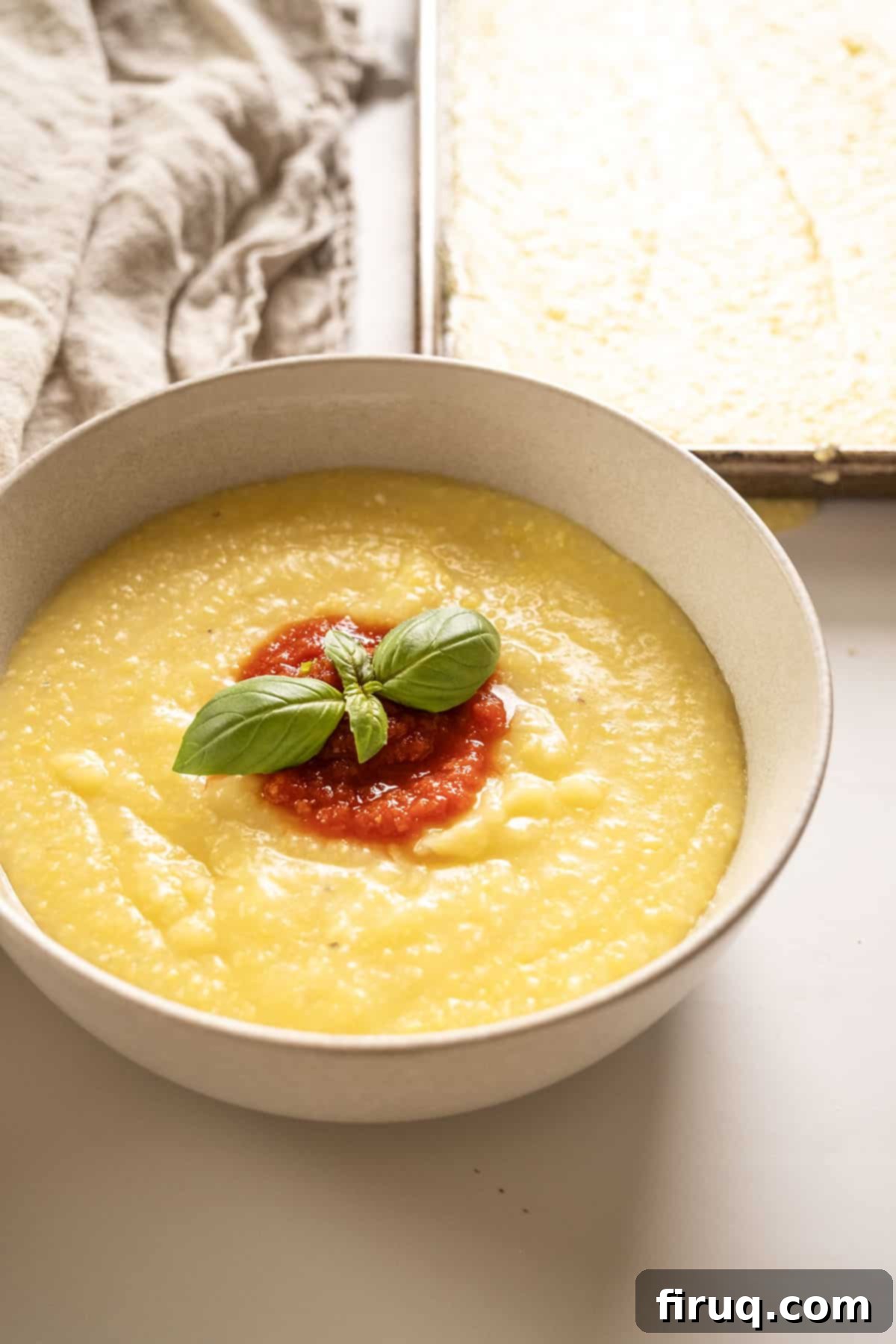
If you appreciate the comforting allure of classic Italian starches like this creamy polenta, be sure to explore other exquisite recipes such as Zucchini Risotto or The Creamiest Mushroom Truffle Risotto for more delightful culinary adventures.
The Enduring Appeal of Classic Italian Recipes
There’s an undeniable magic in classic Italian recipes, epitomized by dishes like this Creamy Polenta served alongside a vibrant Marinara Sauce. The secret lies in their simplicity. These time-honored recipes, passed down through generations, masterfully use just a few high-quality, fresh ingredients to extract the most profound and authentic flavors. It’s a culinary philosophy that prioritizes the natural essence of each component, allowing them to shine without being overshadowed by unnecessary complexity.
Polenta, in particular, deserves a place in everyone’s culinary repertoire, not just for its exquisite taste, but for three compelling reasons:
- Unparalleled Versatility: Polenta is a chameleon in the kitchen, adapting effortlessly to a multitude of dishes. It serves as the perfect canvas for almost any sauce or main course you can imagine. From rich and hearty meat sauces like Bison Ragu to savory poultry dishes such as Easy Chicken Cacciatore, or even simple roasted vegetables, polenta absorbs and complements flavors beautifully. Its mild, comforting profile makes it an ideal accompaniment, enhancing the overall dining experience without overpowering the star of the meal.
- Remarkable Reusability: One of polenta’s hidden superpowers is its ability to transform. While sublime when served fresh and piping hot, leftover polenta can be chilled, solidifying into a firm block. This opens up a world of new culinary possibilities. Imagine slicing it into wedges or squares and making Grilled Polenta with Marinara and Pesto, achieving a delightful crispy exterior and tender interior. Or, you can pan-fry it for a quick, golden-brown side dish, or even bake it into a comforting gratin. This second life makes polenta incredibly economical and resourceful.
- Budget-Friendly Comfort: Polenta is an incredibly affordable ingredient, making it an excellent choice for family meals or cooking on a budget. Compared to other starches like pasta, it offers similar comfort and satiating qualities without breaking the bank. It’s a dish that appeals to all ages, with kids often loving its creamy texture. Plus, it’s perfect for utilizing leftover sauces, turning them into a complete and satisfying meal with minimal effort. It embodies the essence of wholesome, accessible home cooking.
Essential Ingredient Notes and Smart Substitutions
Crafting the perfect creamy polenta hinges on selecting the right ingredients and understanding their role. Here’s a breakdown of what you’ll need and how to make the best choices:
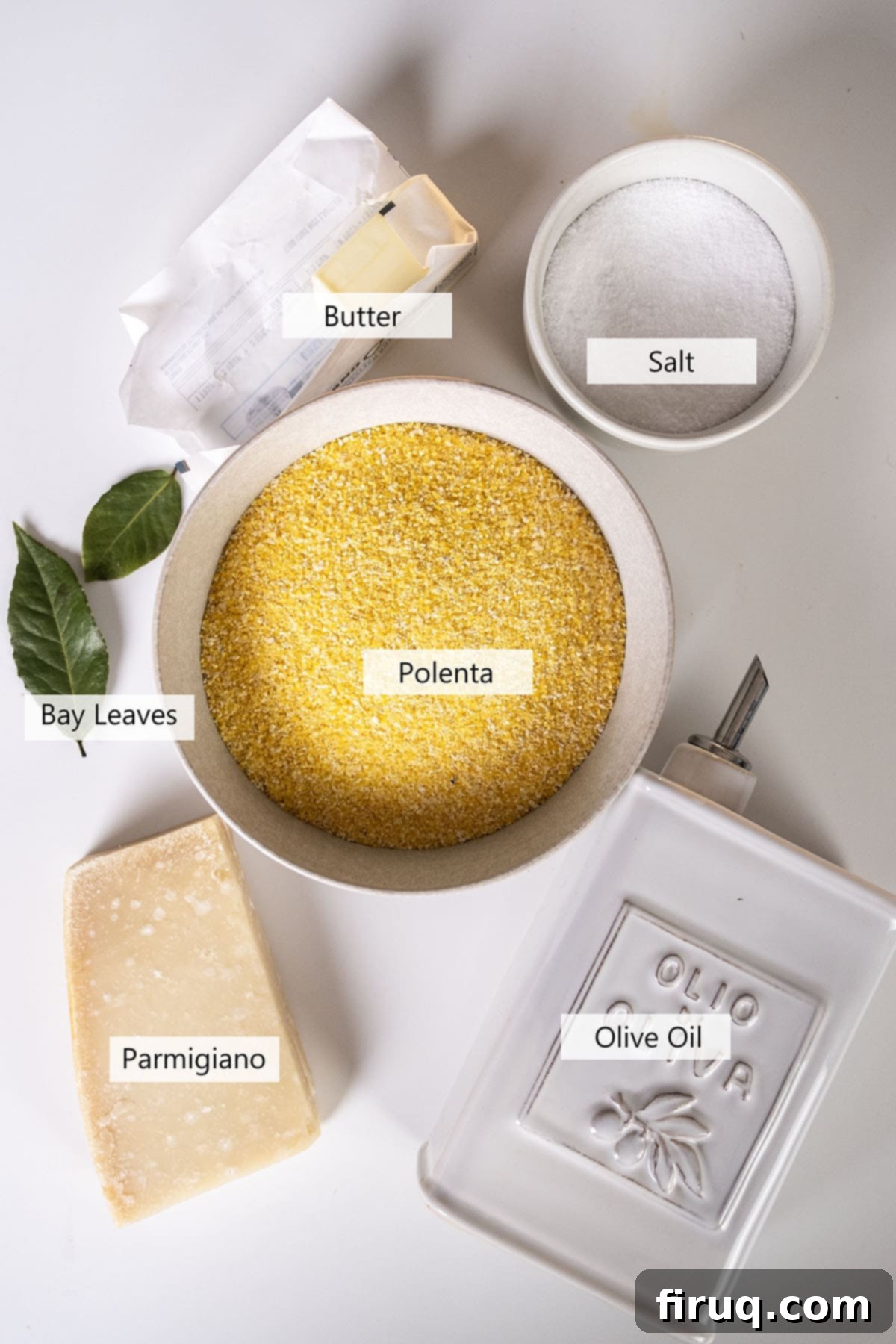
- Polenta (Medium Grit Cornmeal): The type of cornmeal is crucial. For that signature creamy texture, you absolutely want to use a medium grit cornmeal. Fine ground cornmeal can become gluey, while coarse ground can remain too grainy. Resist the urge to substitute with grits; while also corn-based, grits are made from a different type of corn and undergo a different processing, resulting in a distinct texture and flavor that won’t give you the desired polenta outcome.
- Parmigiano Reggiano: This king of Italian cheeses lends a wonderfully nutty, complex, and savory depth to the polenta. For a sharper, more pungent taste, you could substitute Pecorino Romano. However, for a truly classic and smoothly integrated flavor, Parmigiano is the preferred choice, melting beautifully into the hot polenta.
- High-Quality Extra Virgin Olive Oil: Just like in many Italian dishes, the quality of your olive oil here is paramount. A robust, fruity extra virgin olive oil will infuse the polenta with its distinctive aroma and taste from the very beginning. Using a low-quality or bland olive oil will noticeably detract from the overall flavor profile of your finished dish. Choose one you’d happily drizzle over a salad.
- Unsalted Butter: Butter is the secret weapon for achieving that luxurious richness and incredible creaminess. While technically “optional” in its quantity, I highly recommend using a generous amount, up to a full stick, added to taste. The more butter you incorporate, the more decadent and flavorful your polenta will become. This process is very similar to making risotto, where adding butter (known as “mantecatura”) emulsifies with the starch and cheese, building a profound depth of flavor and a silky texture, much like in a Creamy Cherry Tomato Risotto. Always use unsalted butter to control the seasoning precisely.
- Water or Broth: Water forms the simplest base for polenta, allowing the pure corn and cheese flavors to shine. However, for a more savory and complex profile, you can absolutely substitute chicken broth (or even vegetable broth for a vegetarian option). This will impart an extra layer of umami and saltiness, so be sure to adjust your added salt accordingly.
- Salt & Bay Leaves: Don’t underestimate the power of seasoning. Salt enhances all the flavors, while bay leaves add a subtle, aromatic depth that hints at traditional Italian cooking. Remember to remove the bay leaves before serving!
*Please refer to the detailed recipe card below for precise measurements and further ingredient information.
Mastering the Art of Creamy Polenta: A Step-by-Step Guide
The ultimate secret to achieving truly creamy polenta lies in preventing it from clumping or sticking to the pan. This requires attention to detail, especially in the initial stages. The most critical step is to slowly whisk the polenta into cold water. If you add polenta to hot or simmering water too quickly, the starch will gelatinize instantly on contact, forming undesirable lumps that are nearly impossible to smooth out. Furthermore, much like a classic risotto, you’ll need to remain present and stir the polenta frequently throughout the cooking process to ensure even cooking and prevent sticking.
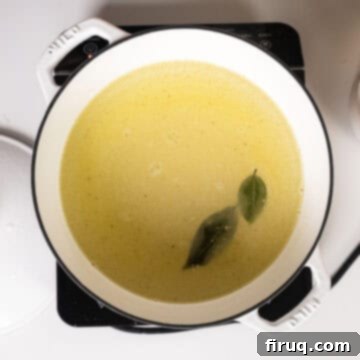
Step 1: Prepare the Base. Begin by adding the measured water, high-quality extra virgin olive oil, bay leaves, and salt into a large, heavy-bottomed pot or Dutch oven. Ensure the water is cold. Next, with one hand continuously whisking the liquid in the pot, very slowly and gradually pour in the polenta in a thin, steady stream from a measuring cup. This slow addition and constant whisking are paramount to preventing lumps. When all the polenta has been incorporated, the mixture should be well combined and appear slightly cloudy, with no visible dry clumps.
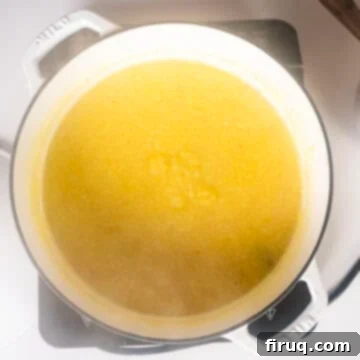
Step 2: Gentle Simmering and Constant Stirring. Place the pot over medium-low heat. Slowly bring the water to a very low, gentle simmer. It’s crucial not to boil vigorously, as this can lead to scorching. As the polenta heats, continue to whisk or stir it often – ideally every few minutes – to prevent it from sticking to the bottom and sides of the pan. Once the mixture reaches a low simmer, reduce the heat further to maintain a gentle bubbling. Continue to cook for approximately 25-30 minutes, ensuring consistent stirring throughout this period to achieve optimal creaminess.
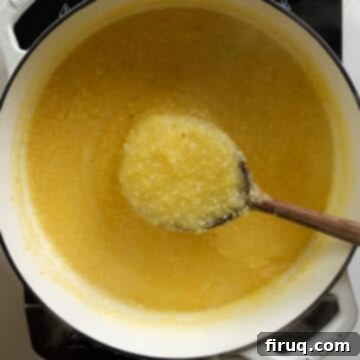
Step 3: Achieving Perfect Consistency. As the polenta cooks, you’ll notice it beginning to thicken significantly. At this point, it’s often easier to switch from a whisk to a sturdy wooden spoon for stirring, as the mixture will become quite dense. Continue to stir frequently, scraping the bottom and sides of the pot to prevent any sticking or scorching. The polenta is ready when it reaches your desired consistency – thick, smooth, and creamy – and begins to “peel away” cleanly from the sides of the pot as you stir, indicating it’s fully cooked and has released its starch.
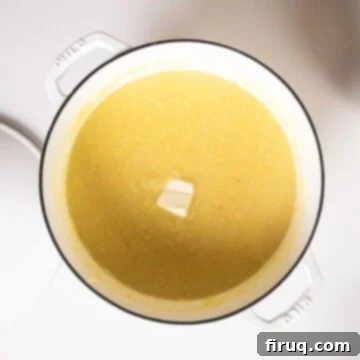
Step 4: Enriching and Finishing. Once the polenta has reached the perfect consistency, remove the pot from the heat. This is where the magic truly happens for creaminess and flavor. Add the unsalted butter, one cube at a time, stirring vigorously after each addition until it completely melts and is fully incorporated. This process, known as “mantecatura,” adds incredible richness and a silky sheen. After all the butter is mixed in, slowly stir in the freshly grated Parmigiano cheese until it melts seamlessly into the polenta, making it even more decadent and flavorful. Once combined, your luxurious creamy polenta is ready to serve immediately, or it can be chilled for later use in other exciting dishes.
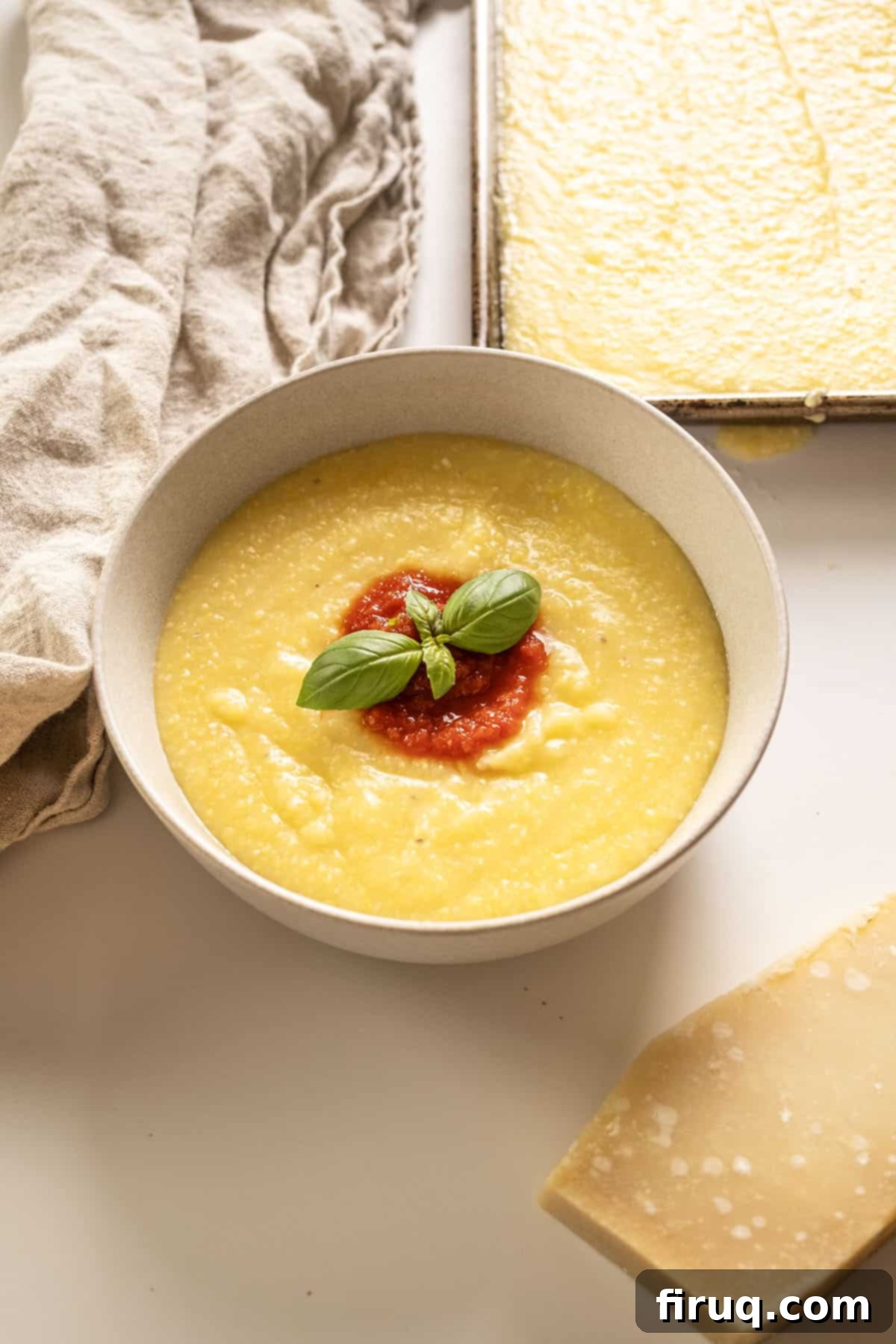
Serve your freshly made creamy polenta immediately, either with a bright, simple marinara sauce for a classic pairing, or as the perfect velvety base under your favorite slow-braised meats. It beautifully complements rich and savory dishes like Italian Short Ribs, Fennel Chicken Thighs in Red Wine, or even the intensely flavorful Authentic Italian Braciole.
Pro-Tips for Perfect Polenta
- Stay Engaged with Your Pot: Polenta is not a set-it-and-forget-it dish. It truly requires your undivided attention. Make it a point to stand by the pot and stir every 2-3 minutes. This constant vigilance is critical to prevent the polenta from sticking to the bottom of the pan, which can lead to burning and an unpleasant texture. Think of it as a meditative, albeit active, cooking process.
- Embrace the Butter: While some might consider butter an optional addition, I cannot emphasize enough how transformative it is for creamy polenta. A generous amount of unsalted butter, stirred in at the end, is what elevates the polenta from merely good to truly rich, luxurious, and unbelievably creamy. It emulsifies with the cornmeal, adding a depth of flavor and silken texture that is simply unmatched. Don’t skip this step for the best results!
- Prepping for Future Dishes: If you plan to chill your polenta to prepare other dishes like grilled or fried polenta, proper preparation for cooling is key. Before pouring the hot polenta into a dish for chilling, ensure the dish is thoroughly greased with a good quality olive oil or butter. This will prevent the solidified polenta from sticking and make it easy to unmold and slice when you’re ready for its next culinary adventure.
Recipe FAQs: Your Polenta Questions Answered
Creamy polenta is incredibly versatile. It shines brightest with simple red sauces or rich meat sauces like Bolognese or Ragu. For a classic experience, serve it with a fresh marinara sauce, perhaps topped with a swirl of pesto for added herbaceous notes. Beyond sauces, it’s a fantastic base for braised meats, roasted vegetables, or even a fried egg for a hearty breakfast or brunch.
No, while both are made from dried, ground corn, polenta and grits are distinct. Grits are typically made from dent corn (a less sweet variety) and are often coarser, resulting in a much starchier texture, sometimes compared to mashed potatoes. Polenta, on the other hand, is usually made from flint corn (a sweeter variety) and is generally more finely ground, yielding a smoother, slightly sweeter, and less starchy consistency that is characteristic of this Italian dish.
Reheating creamy polenta to its original perfect texture can be challenging, as it tends to stiffen and lose its creaminess. For the best results when attempting to return it to a creamy state, you can place it in a pot with a little simmering water, milk, or broth, stirring constantly until it softens. However, a superior approach for reheating is to transform it. Chilled, solidified polenta is ideal for cooking again: slice it and grill, pan-fry, or bake it until golden brown and crispy. This method creates a delicious new dish from your leftovers, like grilled polenta with marinara and pesto.
A heavy-bottomed pot, such as a Dutch oven or a thick stainless steel pot, is ideal for cooking polenta. The heavy bottom distributes heat evenly and helps prevent the polenta from scorching or sticking to the bottom, which is a common issue with thinner pots. A non-stick surface can also be beneficial, but consistent stirring is still key.
Explore More Classic Italian Comfort Recipes
- Authentic Bolognese
- Authentic Italian Lasagna
- Easy Chicken Cacciatore
- Authentic Italian Sunday Sauce
Please leave a comment and a star rating below in the recipe card if you enjoyed this recipe! We always love to hear your thoughts and experiences with our dishes. Feel free to tag us on Instagram @vindelgiudice and share your culinary creations!
📖 Recipe
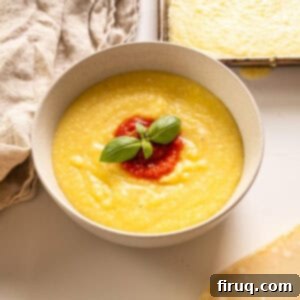
Creamy Polenta
Vincent DelGiudice
Pin Recipe
Equipment
-
1 Large Dutch Oven
Ingredients
- 2 cups medium grain polenta
- 10 cups water
- 1 stick unsalted butter
- ¼ cup extra virgin olive oil
- 1 teaspoon sea salt
- 2 cups freshly grated Parmigiano Reggiano cheese
- 2 bay leaves
Instructions
-
In a large, heavy-bottomed pot or Dutch oven, combine the cold water, olive oil, bay leaves, and salt. While continuously whisking the liquid with one hand, slowly and steadily pour in the medium-grain polenta in a thin stream using a measuring cup. Ensure the polenta is thoroughly incorporated and the mixture appears slightly cloudy, with no dry clumps remaining.
-
Place the pot over medium-low heat. Bring the mixture to a very low, gentle simmer. Continue to whisk or stir the polenta frequently, scraping the bottom and sides of the pan to prevent sticking. Once the water begins to simmer, reduce the heat to maintain a gentle bubbling and continue to cook the polenta for approximately 25-30 minutes, stirring consistently.
-
As the polenta thickens, you may find it easier to switch from a whisk to a sturdy wooden spoon for stirring. Maintain frequent stirring. The polenta is ready when it reaches a thick, creamy consistency and visibly pulls away from the sides of the pot as you stir, indicating it’s fully cooked and smooth.
-
Remove the pot from the heat. Add the unsalted butter, one cube at a time, stirring vigorously after each addition until it completely melts and is fully incorporated, creating a rich and glossy texture. Once all the butter is mixed in, slowly stir in the freshly grated Parmigiano Reggiano cheese until it melts smoothly into the polenta. Remove the bay leaves before serving. Once combined, your creamy polenta is ready to enjoy immediately, or it can be chilled for use in other dishes.
Notes
- Polenta is one of those dishes you really need to monitor. Stand by the pot and stir every 2-3 minutes, or else it will stick to the bottom of the pan and potentially burn.
- Butter is technically optional, but its addition is highly recommended as it significantly enhances the polenta’s richness, depth of flavor, and creamy texture.
- If you are planning to chill the polenta for another dish (e.g., grilled or fried polenta), ensure the cooling dish is generously greased with olive oil or butter to prevent sticking and ease of removal.
Nutrition
